Mapping Methodism – Parade Street United Methodist Free Church, Penzance
Categories Mapping Methodism, Projects0 Comments
This profile of Parade Street United Methodist Free Church, Penzance, has been compiled by Suzanne Trythall.
1851: foundation stone laid of original chapel to be built by J&J Perkins on the site of a former garden in Parade Street
1857: original chapel opened with a gallery being added later
1861: chapel was enlarged
1871: old houses which fronted the building were purchased and demolished
1875: a further extension was built but within 10 years it was clear that the chapel, vestry and schoolroom were inadequate to accommodate the growth in membership and Sunday School scholars
1889: original chapel was demolished
19 April 1889: foundation stones of the new United Methodist Free Church were laid. Two sealed bottles were placed in a cavity below the stones, containing an account of the ceremony, the names of the Circuit officers, the superintendent minister, builders, carpenters and architect as well as coins and copies of two newspapers. The chapel measured 64 feet by 30 feet, built with elvan from Castle-an-Dinas and dressed granite. Schoolroom was built under the chapel.
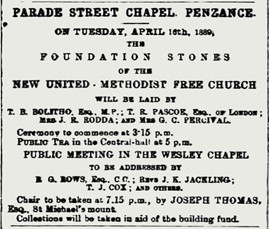 11 April 1889 The Cornishman
11 April 1889 The Cornishman
Architect: Oliver Caldwell of Morrab Terrace Penzance
Builders: Messrs Nicholas and Sons
Woodwork: WH Trounson
Stained Glass: supplied by Watson and Fouracre of Plymouth
Painting and glazing: John Peak of Causewayhead
Gas fittings: supplied by Hulett & Co of London, fitted by TB Stewart of Causewayhead
Encaustic tiles: Maw and Co of Shropshire, world’s largest factory and producer of tiles
Criddle and Smith of Truro and J & A Fuzzey of Market Jew Street supplied fixtures, fittings and other ‘adornments’
Ceiling centrepieces for revolving roof ventilators cast by Mr Tarafini of Plymouth
Organ: Hele & Co of Plymouth took the old organ and the new one cost £180
Cost of building and organ: £2,000 (£500 over original budget and with a debt of £1,450 outstanding on the building)
Capacity: 650 persons
1899: Trust Account Book records annual income of £4. 5s from rent on No. 6 Parade Passage and pew rents amounted to £17 3s 6d.
Chapel keeper salary £3.00, organist £3.15s and organ blower 16s
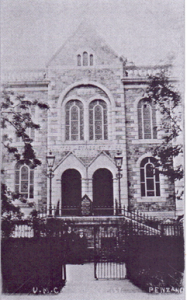 An early postcard photo of chapel with gas lamps and railings. ‘United Methodist Free Church’ is inscribed in masonry above the double doors.
An early postcard photo of chapel with gas lamps and railings. ‘United Methodist Free Church’ is inscribed in masonry above the double doors.
January 1892: Trustees granted the use of the furnace room to enable a soup kitchen to be set up. On the first day it fed about 60 women and children with soup and 30 with 1d worth of bread before supplies ran out.
1907: chapel became Parade Street United Methodist Church and was head of its own Circuit
1921-23: renovation of the exterior, new gas fittings installed and organ reconditioned
1932: chapel became known as Parade Street Methodist Church and continued to run its own Circuit. Trust Account Book records annual income from pew rents £41.12s. Caretaker salary £25.00, organist £20 and organ blower £5.
November 1940: Free Church Evacuation Centre opened in the schoolroom
September 1941: chapel received bomb damage to the roof, two windows and the organ. War damage insurance of £22 10s had been paid. Repairs were carried out by Mr H Rogers of Bread Street for £850 with £50 to replace the two windows. Final account was submitted April 1946. Organ repairs were estimated at £178 10s by Hele & Co.
1941-1946: Services were held in the Schoolroom
July 1946: re-opening of the chapel with two days of celebration
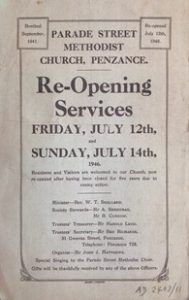 Photo of document AD2403/11 Archives and Cornish Studies Service, Redruth: front cover of programme of events to celebrate re-opening of the chapel
Photo of document AD2403/11 Archives and Cornish Studies Service, Redruth: front cover of programme of events to celebrate re-opening of the chapel
August 1946: new stained glass window unveiled in memory of Elizabeth Ladner 1865-1942
September 1946: new stained glass window depicting Dorcas unveiled in memory of Ann Kennard 1860-1945
January 1968: the Methodist Church Department for Chapel Affairs sanctioned the sale of the chapel
Membership at closure was 100
April 1968: offer of £3,500 for the building was accepted from the Penzance Players plus £50 for the pews. The organ was to be sold for as much as they could get, but it was in very poor condition according to Hele & Co. The memorial windows were removed and boarded up at a cost of £50. The pulpit was removed by voluntary labour. Proceeds of the sale were handed to the Senior Steward of the Penzance Circuit and distributed in varying amounts amongst eight local chapels.
1970s: funding secured from the Arts Council and the chapel ground floor and balcony were converted to a 250-seat auditorium
1979: renamed Penzance Arts Centre
1980-1996: Centre was in crisis and on brink of closure, being threatened with re-use as a furniture store
1996-2010: the old chapel was in urgent need of refurbishment and modernisation. There was dry rot in the timbers and access was difficult. A lottery grant and other funding were secured and Parade Street Chapel became ‘The Acorn’.
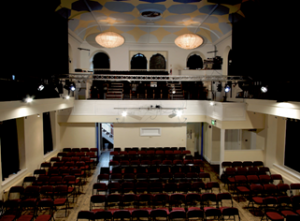 Photo permission of The Acorn Manager: theatre auditorium in former chapel
Photo permission of The Acorn Manager: theatre auditorium in former chapel
 Photo January 2021 of the Acorn
Photo January 2021 of the Acorn
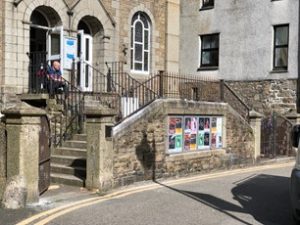 Photo March 2021: installing new railings and gates to replicate those removed during the Second World War
Photo March 2021: installing new railings and gates to replicate those removed during the Second World War
Sources and further reading:
Newspapers: The Cornishman and The Cornish Telegraph (Find My Past)
Book: ‘Even in This Place: 19th century Nonconformists & Life in the Borough of Penzance’ by John Horner (2010)
Website: Newlyn Trinity Church: Methodism in West Penwith – A Heritage at Risk
Map: The National Library of Scotland
Souvenir Brochure: The Acorn Celebrating 50 Years 1969-2019
Kresen Kernow
Linda Camidge of Penwith Local History Group
The Morrab Library
